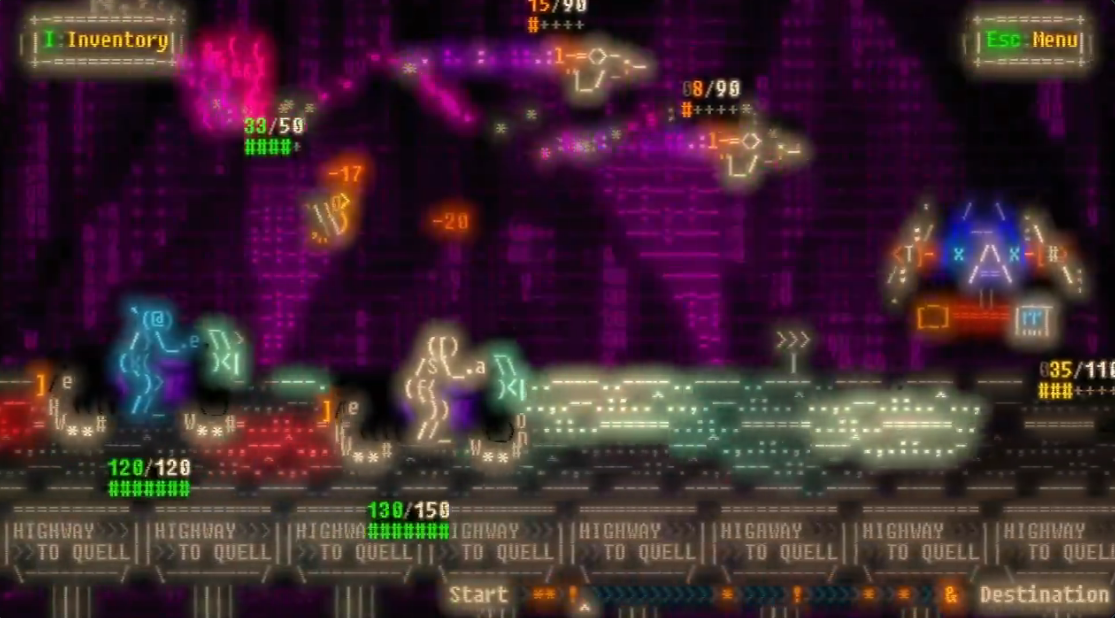7 video game art styles to consider for your game
Game art styles have multiplied dramatically in my lifetime. From the 256x192-pixel resolution and 15 colours I remember on the ZX Spectrum to 3D graphics that look almost indistinguishable from the real world, art styles have developed in response to the possibilities that hardware and software have allowed at any given time.
This means that today there's a rich variety of game art styles to choose from, with infinite sub genres popping up along the way. What's the best game art style for your game? Nobody can say since it depends entirely on your idea, but below I'll sum up the most popular game art styles in use today to provide some ideas and inspiration.
I'll also suggest what software you might use for each, although you might also want to see our guides to the best game dev software and the best laptops for game dev.
01. 3D realism
If you've played an AAA game in recent years, you're likely to be with familiar with photoreal 3D game art, which has become one of the most popular game art styles today. While it's traditionally dominated in AAA games like Call of Duty and the Last of Us, 3D realism is also becoming much more accessible to indie devs thanks to software like Epic Games' Unreal Engine 5 combined with 3D scanning and mocap technology.
The ultra-realistic multiplayer FPS Bodycam (above) is a game that's taken 3D realism to another level, and Reissad, the studio behind it, is an independent. 3D realism aims to create virtual environments and characters that closely resemble the physics of the real world. This is achieved by referencing real-world objects and models, creating high-resolution 3D models, detailed sculpting, texturing and baking to transfer details from a high-poly model to a low-poly model for performance optimization. .
The aim of realistic 3D game art is to immerse players in a believable, visually stunning experience that creates both visual and emotional impact. On the downside, 3D art is resource-intensive and will often require a high-end PC or console, potentially excluding many gamers. It takes a lot of time and work and isn't usually an option for solo developers. And while 3D games might look the most cutting edge at any given moment, the art style can age quickly as technology continues to advance.
Of course not all 3D realism aims to recreate the world we know. Fantasy realism is sometimes considered as separate game art style of its own since it aims to depict fantastical fictional settings in a way that looks just as real and believable as our world, as has been popularised in game franchises like The Witcher and God of War.
Daily design news, reviews, how-tos and more, as picked by the editors.
Unreal Engine 5 is fast becoming the most popular engine for 3D games, but Unity is also an option. For modelling and animation, you have the likes of Maya, 3ds Max and Blender (see our guide to the best 3D modeling software).
02. Pixel art
At the opposite end of the spectrum of game art styles is a look that harks back to the golden age of early video games. The term 'pixel art' wasn't used back in the day – the developers of early games used the technique out of necessity, making the most of limited resources by using a grid of blocks in limited colours to create that distinctive pixelated look.
If you're not familiar with the indie game scene, you might think pixel art games had been consigned to history, but there are many contemporary games that use the style with varying degrees of rigidity, such as Hyper Light Drifter above. Some use it to create a sense of nostalgia, but pixel art doesn't have to look retro since today you can opt to use a much broader palette than the original 16 (4-bit) or 256 (8-bit) colours that devs had available (see Bionic Bay as an example).
03. Vector game art
While pixels are used to build raster graphics, vector game art uses mathematical equations to define shapes, lines, and colors. Like with vector art in graphic design and other uses, this means the artwork can be scaled to any size without a loss of quality. In game design, this can provide a lot of flexibility for different screen sizes and resolutions.
Vector graphics have been used in games since way Spacewar! way back in 1962 right up to more contemporary titles as varied as Monument Valley and Castle Crashers (above). The style is sometimes maligned for its association with cheap mobile and flash games, but it can be a great solution for certain games – and you don't have to use thick black outlines . Adding shading with pixel brushes can make vector art that looks attractive in the right game.
Vector graphics have the advantage of small file sizes, hence why they're a popular choice for light mobile games. Thy can provide fast loading times and better performance, and they're easy to create and modify using software like Adobe Illustrator and CorelDRAW or free, open-source Inkscape (see our guide to the best digital art software).
04. Low-poly game art
Like pixel art, low-poly game art is an immediately recognisable product of computing limitations of a certain era. Early 3D games needed to use low polygon counts because of the limited processing power and memory on mid-1990s consoles such as the Nintendo 64 and the original PlayStation.
Low poly counts gave us Super Mario 64, The Legend of Zelda: Ocarina of Time and Tomb Raider. Today, they style is often seen as dated and something that was only used due to the limitations of the time, but low-poly game art can still be an option depending on your audience's expectations – just look at the success of Minecraft (above). Crow Country and Sorry, We're Closed have also achieved success with the style.
You can make low-poly game art directly in a game engine like Unity, but it's often more efficient to use 3D modeling software like Blender to create the initial assets and then import them, especially for more complex models and detailed scenes. Just remember that although it can be easier to make a low-poly game art style look good than 3D realism, it's still a lot more complex and time-consuming than using 2D art.
05. Cel-shaded game art
Cel shading, also known as toon shading, is a 3D game art style, but it doesn't aim for realism. Instead, 3D art is given flat, stylised look to make it look more cartoon-like. This is done by simplifying the shading and lighting and using flat solid colors, often with bold outlines, rather than smooth gradients and subtle shading.
A limited colour palette is often used, along with limited lighting sources to create sharp transitions between light and shadow. The aim is sometimes to create a feeling of nostalgia, playfulness or escapism, and it can also sometimes have the advantage of better performance on less powerful hardware (in comparison with 3D realism).
The Legend of Zelda: The Wind Waker is a magnificent example. The art style doesn't strive for realism, but the world feels expressive and vibrant. In a game engine, cel-shading is usually done in a shader. You can use software like Blender, Maya or 3ds Max to create the 3D models.
06. Hand-drawn game art
If you don't follow indie game trends, you might be surprised to learn that hand-drawn game art is even a thing these days, but it's very much a live, and a fantastic way to creating stunningly original-looking games, whether the art is made traditionally or digitally.
The handcrafted approach can add a charm and craftsmanship that creates a unique atmosphere, making hand-drawn game art a great choice for story-driven games or those that aim to create a strong emotional connection.
Some games use a hand-drawn art style to evoke nostalgia for a particular era, like Cuphead's referencing of classic 1930s animation (above). But hand-drawn art doesn't need to be associated with any specific era either, and it can help a game to feel timeless.
As well as hand-drawn, I'll include here hand-modelled game art because we've seen some really unique-looking games recently that use a stop-motion animation style with clay models, including Harold Halibut and The Midnight Walk.
If you work by hand on paper, you'll need to scan and digitise your art, or you can draw directly into digital art software like Photoshop. For claymation art, models are 3D scanned using a camera, and then retopologized, rigged and animated – often via mo-cap.
We've spoke to the developers behind many unique handcrafted game art styles. See our piece on the best indie game developers for inspiration.
07. Monochromatic game art
There's been a lot of interest in monochromatic game art recently, most often black and white. This isn't exactly a single game art style since it can be made with various approaches, and it can range from stark, minimalist art to retro animation styles like in upcoming Kalit or more detailed and textured work. But games with limited colours share certain challenges – as well as potential advantages.
One of the challenges with monochromatic game art is creating depth. This can be achieved by using darker shades for shadows and recesses, and lighter shades for highlights. Negative space is important to help define the shapes and forms of objects, and hatching and cross-hatching can be used to create texture and tonal variation.
The puzzle-platformer Limbo (above) used a monochrome game art style to create an intensely eerie atmosphere that was beautifully mysterious and evocative. The upcoming Severance-inspired game PAGER uses black-and-white 1-bit 3D graphics to create a world that feels familiar but unsettling.
How do I choose the best game art style for my game?
There's no such thing as a best game art style since it depends on your idea, your resources and what your game's intended audience will enjoy. Some types of games lend themselves to certain game styles, or at least their audiences may have expectations of what such a game should look like.
A game should usually be conceived as a whole: the art style and the gameplay need to be considered together. But financial resources are also likely to influence your decision. Even with more accessible software like Unreal Engine 5, it's unlikely that you would be able to make an expansive open-world game with 3D realism alone.
Creating game assets can be a challenge for solo devs, both in terms of time and money, but you could also consider using free video game assets at least as placeholders to begin with.

Joe is a regular freelance journalist and editor at Creative Bloq. He writes news, features and buying guides and keeps track of the best equipment and software for creatives, from video editing programs to monitors and accessories. A veteran news writer and photographer, he now works as a project manager at the London and Buenos Aires-based design, production and branding agency Hermana Creatives. There he manages a team of designers, photographers and video editors who specialise in producing visual content and design assets for the hospitality sector. He also dances Argentine tango.
You must confirm your public display name before commenting
Please logout and then login again, you will then be prompted to enter your display name.








